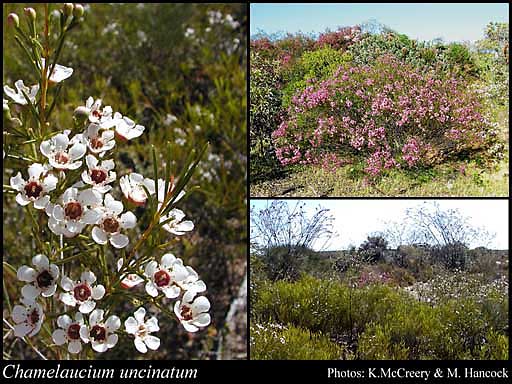- Reference
- Lehm., Pl.Preiss. [J.G.C.Lehmann] 1:97 (1844)
- Conservation Code
- Not threatened
- Naturalised Status
- Mixed (Native in Part of Range, Naturalised Elsewhere)
- Name Status
- Current
Erect shrub, 0.5-4 m high. Fl. white-pink, Jun to Nov. White, grey or yellow sand, over limestone, laterite. Coastal areas, edges of swamps, hillsides, plains.

Distribution
- IBRA Regions
- Avon Wheatbelt, Esperance Plains, Geraldton Sandplains, Jarrah Forest, Swan Coastal Plain, Warren.
- IBRA Subregions
- Dandaragan Plateau, Fitzgerald, Geraldton Hills, Lesueur Sandplain, Merredin, Northern Jarrah Forest, Perth, Warren.
- IMCRA Regions
- Central West Coast.
- Local Government Areas (LGAs)
- Armadale, Busselton, Cambridge, Carnamah, Chapman Valley, Chittering, Claremont, Coorow, Cottesloe, Dandaragan, Fremantle, Gingin, Gosnells, Greater Geraldton, Irwin, Jerramungup, Joondalup, Kalamunda, Manjimup, Melville, Moora, Mosman Park, Narembeen, Nedlands, Northampton, Perth, Quairading, Serpentine-Jarrahdale, South Perth, Stirling, Subiaco, Swan, Wanneroo, Waroona, York.
Management Notes (for the Swan NRM Region)
General Biology. Growth form. Shrub. Reproduction. Seed. Dispersal. Water, soil movement, garden refuse. Time to first flowering. 2 years. Vegetative regeneration strategy. Resprouts from the base. Seedbank persistence. Medium. Fire response. Following fire prolific germination of soil-stored seed occurs and mature plants can resprout.
Notes. In the Perth area , Chamelaucium uncinatum is thought to only occur naturally on the coastal (Quindalup) dunes between Perth and Geraldton. A culivated variant has been widely planted and has escaped into many local bushlands. Can cause major structural changes to the plant communities that it invades.
Additional information. Origin. Midwest Western Australia. History of use/introduction. Garden escape, amenity plantings.
Suggested method of management and control. Cut to base and paint with 50% glyphosate. Control seedlings following fire. Read the manufacturers' labels and material safety data sheets before using herbicides. For further information consult the Australian Pesticides and Veterinary Medicines Authority to determine the status of permits for your situation or state.
Management Calendar
| Calendar Type | Jan | Feb | Mar | Apr | May | Jun | Jul | Aug | Sep | Oct | Nov | Dec | Comments |
|---|---|---|---|---|---|---|---|---|---|---|---|---|---|
| Flowering | O | Y | Y | Y | Y | Y | Y | O | |||||
| Fruiting | Y | Y | Y | Y | Y | Y | |||||||
| Optimum Treatment | Y | Y | Y | Y | Y | Y | Y | Y | Y | Y | Y | Y |
Legend: Y = Yes, regularly, O = Occasionally, U = Uncertain, referred by others but not confirmed.
References
- Brown, K. & Brooks, K. (2002) Bushland Weeds: A Practical Guide to their Management. Environmental Weeds Action Network, Greenwood.
- Hussey, B.M.J., Keighery, G.J., Dodd, J., Lloyd, S.G. & Cousens, R.D. (2007) Western Weeds. A guide to the weeds of Western Australia. 2nd Edition. The Plant Protection Society of Western Australia, Victoria Park.
- Navie, S. & Adkins, S. (2008) Environmental Weeds of Australia, An interactive identification and information resource for over 1000 invasive plants. Centre for Biological Information Technology, The University of Queensland.